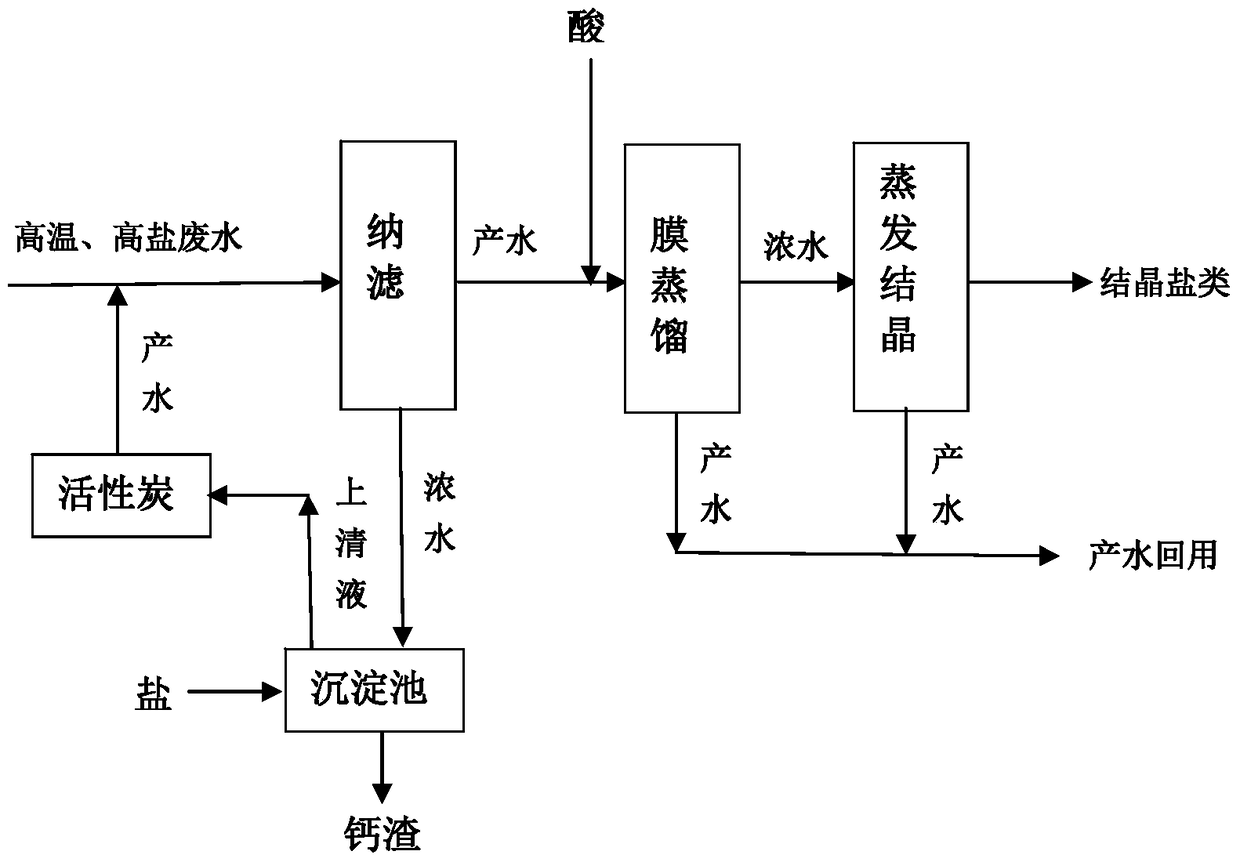A zero-discharge method for high-temperature and high-salt wastewater
A high-temperature, high-salt, zero-discharge technology, applied in chemical instruments and methods, water/sewage multi-stage treatment, water/sludge/sewage treatment, etc. Significant social and environmental benefits, reducing energy consumption, and achieving high-efficiency utilization
- Summary
- Abstract
- Description
- Claims
- Application Information
AI Technical Summary
Problems solved by technology
Method used
Image
Examples
Embodiment 1
[0084] For a schematic diagram of the process, see figure 1 . The water quality characteristics of high-temperature and high-salt wastewater in the figure are: wastewater temperature 60°C, wastewater pH 6.5, conductivity 10000μs / cm, COD cr 0 mg / L, Na + 2000mg / L, Cl - 2500mg / L, total hardness (CaCO 3 ) 1000mg / L.
[0085] Proceed as follows:
[0086] (1) Nanofiltration. The high-temperature and high-salt wastewater with a certain temperature enters the nanofiltration unit for nanofiltration treatment to remove multivalent ions such as hardness and a small amount of organic matter in the high-temperature and high-salt wastewater.
[0087] After separation and concentration by the nanofiltration unit, the nanofiltration product water enters step (2) for processing, and sodium carbonate is added to the nanofiltration concentrated water to precipitate calcium ions to obtain calcium residue, which is then concentrated and dried. The dosage of sodium carbonate is Ca 2+ : The mo...
Embodiment 2
[0102] For a schematic diagram of the process, see figure 1 . The water quality characteristics of high-temperature and high-salt wastewater in the figure are: wastewater temperature 70°C, wastewater pH 7, conductivity 15000μs / cm, COD cr 50mg / L, Na + 3000mg / L, Cl - 3500mg / L, total hardness (CaCO 3 ) 2000mg / L.
[0103] The operation steps of embodiment 2 are the same as embodiment 1. Wherein, the difference from Example 1 is that sodium sulfate is added to the nanofiltration concentrated water to precipitate calcium ions, and the dosage of sodium sulfate is Ca 2+ : The molar ratio of sodium sulfate is 1:1; the supernatant of nanofiltration concentrated water after calcium ion precipitation is adsorbed by granular activated carbon, and the dosage of granular activated carbon is granular activated carbon:COD The mass ratio is 10:1 ; The pH of the nanofiltration product water is adjusted to 6.5 with hydrochloric acid, and then enters the membrane distillation unit for deep c...
Embodiment 3
[0117] For a schematic diagram of the process, see figure 1 . The water quality characteristics of high-temperature and high-salt wastewater in the figure are: wastewater temperature 80°C, wastewater pH 7.5, conductivity 20000μs / cm, COD cr 80mg / L, Na + 4000mg / L, Cl - 5000mg / L, total hardness (CaCO 3 ) 3000mg / L.
[0118] The operation steps of embodiment 3 are the same as embodiment 1. Wherein, different from Example 1, the nanofiltration concentrated water is added with a mixture of sodium carbonate and sodium sulfate for precipitation of calcium ions, and the dosage of the mixture of sodium carbonate and sodium sulfate is Ca 2+ The molar ratio of (sodium carbonate+sodium sulfate) is 1:1; the supernatant of nanofiltration concentrated water after calcium ion precipitation adopts powdered activated carbon to carry out activated carbon adsorption, and the dosage of powdered activated carbon is powdered activated carbon: the quality of COD The ratio is 2:1; the nanofiltrati...
PUM
| Property | Measurement | Unit |
|---|---|---|
| pore size | aaaaa | aaaaa |
| hardness | aaaaa | aaaaa |
| hardness | aaaaa | aaaaa |
Abstract
Description
Claims
Application Information
 Login to View More
Login to View More - R&D
- Intellectual Property
- Life Sciences
- Materials
- Tech Scout
- Unparalleled Data Quality
- Higher Quality Content
- 60% Fewer Hallucinations
Browse by: Latest US Patents, China's latest patents, Technical Efficacy Thesaurus, Application Domain, Technology Topic, Popular Technical Reports.
© 2025 PatSnap. All rights reserved.Legal|Privacy policy|Modern Slavery Act Transparency Statement|Sitemap|About US| Contact US: help@patsnap.com

